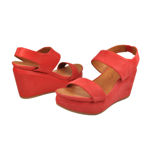OCCUPATIONAL
FOOTWEAR: WHAT TO LOOK FOR WHEN CHOOSING A SHOE FOR ALL DAY COMFORT
Dr. Cathleen
A. McCarthy
After I completed my first two years of
Podiatry school where I basically sat all day in classes and then went home and
spent more time sitting and studying, I was unceremoniously tossed into my
third year where I was expected to stand on hospital floors for ten to twelve
hours a day.
To make a long story short: I was in
agony!
I finally understood why all those
lectures on ‘Heel Pain’ were so important – and relevant! Throughout the third
year, I had a recurring nightmare where I would wake up in the middle of the
night convinced that an evil ogre was hammering a nail straight up into my heel
and I desperately tried various kinds of shoes – searching for that illusive,
magical shoe that would help me get through the day comfortably.
Ironically enough, even though I was in
Podiatry school, we spent most of our time learning surgery and medicine but I
don’t remember a lot of lectures on what constituted a ‘good shoe’. Our
professors did talk about advising patients to wear ‘good shoes’ but few ever
specified exactly what that meant.
Once in private practice, I began to
realize what a crucial role proper shoes play in a helping patients get better
faster. I also realized that what works for one patient may not necessarily
work for another patient with a very different foot issue. In other words,
proper shoes for patients are pathology specific and depend on the patient’s
biomechanical foot structure as well as history of previous problems and
injuries.
I came up with some basic rules for
picking comfortable shoes for all day wear on concrete floors and, although
there are always exceptions to the rules, these rules work for most patients.
First, you should always look for a shoe
with a thick, rigid sole.
This is counter-intuitive because most people look for a ‘soft flexible’ sole
thinking that it will be more comfortable. In reality, it’s the exact opposite!
You need a thick, rigid sole with less motion and less flexibility so that it
is more protective of the foot joints, muscles and tendons. Think of it this
way, if you broke your wrist, your doctor would put you in a cast and you would
instantly feel more protected and have less pain. Less motion equals less
pain.
Second, you should try to find a shoe with
good arch support.
Most shoes come with removable insoles so that you can replace it with either a
custom-molded insert or an excellent over-the-counter insert that offers arch
support. Ninety percent of people will benefit from arch support while ten
percent of people cannot tolerate arch support. Proper arch support can help
with knee, hip and lower back pain and decrease ‘tired-leg syndrome’ at the end
of a long day on concrete floors.
Third, you need a wide, soft toebox. Avoid any shoes with pointy-toes as they
can cause hammertoes, bunions, corns and calluses.
Forth, make sure that whatever shoe you
choose has proper rearfoot control. In other words, your shoes should have no open backs. If your shoe doesn’t have
rearfoot control, you are forcing your tendons, muscles, knees, hips and lower
back to work harder to keep your foot in your shoe. This causes more
‘mechanical strain’, which leads to increased discomfort and chance of injury.
Here are some specific shoe
recommendations that are pathology specific:
For the young, healthy person with strong
legs and no significant foot or ankle deformities, I would recommend the Dansko
or Sanita Clog with rearfoot control.
For a young, healthy person with no history of balance issues, Achilles
Tendonitis, nerve damage or weak legs, I would suggest you try the MBT,
Sketcher-Shape-Up or the New Balance Rock and Tone shoe. Each of these are ‘rocker-bottom’ shoes,
which can be extremely comfortable. I do recommend that you wear arch support
with these shoes – whether it’s custom-molded or over-the-counter inserts.
For a person who may have more serious
foot issues such as diabetes, nerve damage, balance issues or weak legs, I
recommend trying the New Balance 928, which is an extra-depth shoe with a thick, rigid sole and a wide
base. If you have trouble reaching your feet due to hip and knee replacements,
you can get the NB 928 with Velcro-strapping. I highly recommend that if you do
have these more serious medical issues, please consult your Podiatrist to make
sure this shoe is right for you.
For virtually anyone, try the Crocs Rx
clog and make sure to wear the strap to the back so that you get some rearfoot
control. These are not for everyone but there is a reason why you see so many
nurses and doctors in Crocs!
Let’s not forget the guys! For the man who
is on his feet all day in tough conditions, my personal favorite is the p.w.
Minor Hercules, which is
an extra-depth boot with a hidden shank in the sole that is very protective and
comfortable.
I hope this has been helpful!
Sincerely,
Dr. Cathleen A. McCarthy






